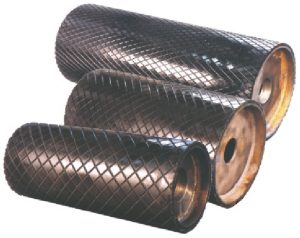COLD ADHESION TO DRUMS OF CONVEYOR BELTS
Cold adhesion using ordinary, fire-resistant liners permissible for use in underground mining settings.

We propose this method with roller drums that are subject to high loads and driver drums that are under medium loads. The lining used for covering the drum is made in moulds, which assures its uniform density and the resulting durability. The high quality of the adhesive used in this method assures high durability of the rubber-metal bond.
Drums can be sent in for refurbishment with shafts and their seats without limit as to their size, diameter or length. The materials used in these techniques can be permissible for use in underground mining settings.
APPLICATION OF TIGHT-SEALING RUBBER TILES
We offer application of rubber tiles (up to 30 mm in thickness) to containers and hoppers for small fractions of material (ore, sand etc.).
The use of these rubber parts increases resistance to wear and reduces noise emissions.
VULCANISATION IN OF DRUMS FOR CONVEYORS IN AUTOCLAVES
Vulcanisation of a fire-resistant, general-use mixture with permissions for use in underground mining settings in autoclaves.
We recommend this method for use in rubberising roller or drive drums that are lightly loaded. The lining use for adhesion to the drums is applied in strips directly from the press, banded and then vulcanised in an autoclave. The high quality of the adhesive used in this method assures high durability of the rubber-metal bond.
Drums can be sent in for refurbishment with shafts and their seats without limit as to their size, diameter or length. The materials used in these techniques can be permissible for use in underground mining settings. Drums can be sent in for refurbishment with shafts and their seats without limit as to their size, diameter or length. The materials used in these techniques can be permissible for use in underground mining settings.